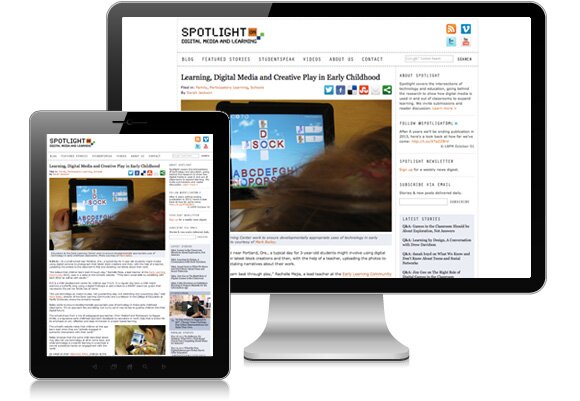At , we redesigned the site, wrote the daily blog, created feature stories, produced a series of videos, and managed a newsletter with several thousand subscribers. The online magazine showcases the people and projects in the MacArthur Foundation’s , going behind the research to show how digital media is used in and out of classrooms to expand learning. We also created a series of e-books from the rich material.
Website
Client:

By Sarah Jackson
At a small school near Portland, Ore., a typical day for 3-year-old students might involve using digital cameras to photograph their latest block creations and then, with the help of a teacher, uploading the photos to the classroom’s iPad and dictating narratives about their work.
“We believe that children learn best through play,” Rachelle Mejia, a lead teacher at the (ELC), says in a video on the school’s website. “They learn social skills by socializing with each other as well as with adults.”
ELC is a child development center for children age 3 to 6. In a regular day here, a child might examine a butterfly wing using a digital ProScope or add a block to a SMART board bar graph that represents the pet her family has at home.
“We use technology as means to play, not supplanting play, but extending and supporting play,” said , director of the Early Learning Community and a professor in the College of Education at Pacific University where the school is housed.
Bailey works to ensure developmentally appropriate uses of technology in these early childhood classrooms. It’s an approach few are taking, but turns out it may be key to guiding children into their digital future.
The school draws from a mix of pedagogical approaches—from Waldorf and Montessori to Reggio Emilia, a progressive early childhood approach developed by educators in north Italy that is known for its emphasis on art, reflection and deep immersion in project-based learning.
The school’s website notes that children at this age learn best when they are “actively engaged in authentic interactions with their world.”
Bailey stresses that the same child described above may also not use technology at all on some days, and while technology is a tool for learning in preschool, it cannot substitute hands-on engagement with the world.
As noted on their , children at the Early Learning Community are busy with many non-technical activities associated with the preschool years: riding bikes in the play yard; eating mangoes as part of the study of fruit bats; making sculptures out of ice or clay; visiting the local post office to mail a letter; and making pizza to be devoured later in the day at snack time.
Bailey says that the technology in the classrooms at the school is “almost invisible.”
“It’s always kind of sexy to begin with, and everyone clamors for it, but now it’s just part of the classroom, like the magic markers. It’s just one of the choices.”
